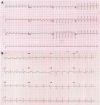Yoga in the emergency room: termination of SVT with the Child's pose
- PMID: 40443873
- PMCID: PMC12118076
- DOI: 10.1093/omcr/omaf049
Yoga in the emergency room: termination of SVT with the Child's pose
Abstract
We present the case of a 27-year-old woman who has successfully self-managed her supraventricular tachycardia (SVT) episodes since her teenage years using the Child's Pose, a technique adapted from yoga. This non-pharmacological approach enabled her to independently terminate SVT episodes, a capability confirmed in a controlled clinical setting where the patient's return to sinus rhythm was immediately achieved upon assuming the pose. The Child's Pose represents a solitary and patient-empowering intervention, contrasting with the assistance-dependent modified Valsalva manoeuvre. This case demonstrates the potential for yoga-influenced practices in the personalized management of cardiac arrhythmias.
Keywords: Valsalva; atrioventricular nodal Re-entrant tachycardia (AVNRT); autonomic nervous system modulation; non-invasive cardiac management; supraventricular tachycardia (SVT); vagal manoeuvres; yoga therapy.
© The Author(s) 2025. Published by Oxford University Press.
Conflict of interest statement
No funding was received for this case report, and the authors declare no conflict of interest. Written informed consent was obtained from the patient for publication of this case report and accompanying images adhering to all local ethical policies.
Figures
References
Publication types
LinkOut - more resources
Full Text Sources



